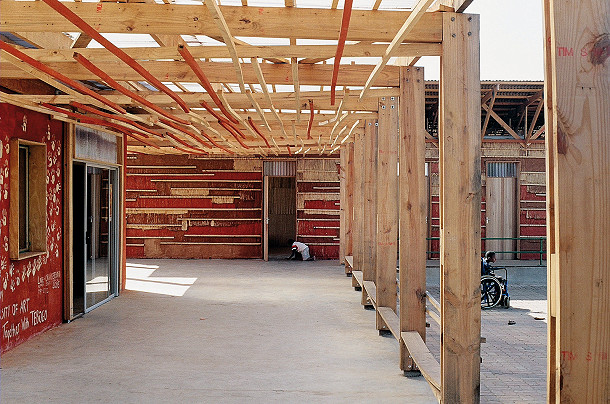Creating living spaces in places that are characterized by rather specific conditions is a complex task that requires a well-thought out approach. The town of Johannesburg in South Africa is a prime example of such specialized areas – there is, for example, an issue of weather conditions and temperature of the extra hot climate. Moreover, the town is known for poverty, AIDS, and unemployment which also makes it difficult to design affordable and comfortable living spaces (Hill, 2015). The materials that locals use for building their shacks are car parts, corrugated iron, or sheet metal, which do not provide good insulation qualities (BASEhabitat, 2021). Thus, it is only logical that in summer, it gets extremely hot in these buildings, and in winter, they never provide enough warmth. To design a proper living space in those conditions, one would need to consider every aspect of all these issues.
Living Tebogo is a home for handicapped children located in the Orange Farm of Johannesburg. BASEhabitat, which is a project studio based at the Kunstuniversität Linz in Austria, took upon themselves to build a new living space there that would address the specific problems locals and their disabled children face. Polak (2007) adds that affordable design begins with learning all the specifics poor customers represent, and how much of their needs they can cover financially. According to Hill (2015), “the project illustrates how earth construction incorporates the local community in the process, saves money on imported materials, and improves indoor conditions without the need for mechanical means” (para. 1). While the direct benefits, such as affordability of materials and better insulation qualities are obvious, the flow on effect lies in educating the locals on how to build comfortable living spaces later in the future.

The students used clay, wood, straw, concrete, and other natural means to build living spaces with better insulation and accessibility. Thus, several areas were designed and created, such as dining hall and kitchen, sanitary facilities, and a garden hallway between buildings (BASEhabitat, 2021). Using only materials provided by the locals and collaborating with community, the students were able to build spaces that would not be affected by weather as much as before. This is an example of how taking into account specifics of the surrounding area, social environment, and needs of the people could be useful when designing living spaces.
References
BASEhabitat. (2021). Living Tebogo Home for handicapped children in South Africa. BASEhabitat.
Hill, J. (2015). Living Tebogo.
Polak, P. (2007). Design for the other 90%. (C. E. Smith, Ed.). Cooper-Hewitt, National Design Museum, Smithsonian Institution.